Ryzen 5 3600 vs. R5 2600: GPU Scaling Benchmark Test - stilesthicaltat
Last August later much demand I locked myself away for a few days to benchmark... Exactly to represent clear, No unrivaled requested I had to be locked gone, but that's just what it took in rank to get all 900 benchmark runs done. With the exit of 3rd-gen Ryzen many gamers wanted a detailed GPU scaling benchmark. That's what we lay outgoing to deliver, examination four GPUs with threesome different CPUs at deuce resolutions, three quality presets, and four games.
The goal was to see how the most affordable radical Ryzen (R5 3600) and then most expensive 3rd-gen processor (R9 3900X) compared to the CORE i9-9900K, the humans's top gambling CPU. In short, the Ryzen 5 3600 well-tried to be the best value option for gamers, more ofttimes than non coordinated the Ryzen 9 3900X. Using an RTX 2080 Ti with medium quality settings at 1080p, the affordable Ryzen was just 14% slower on average when compared to the 9900K.
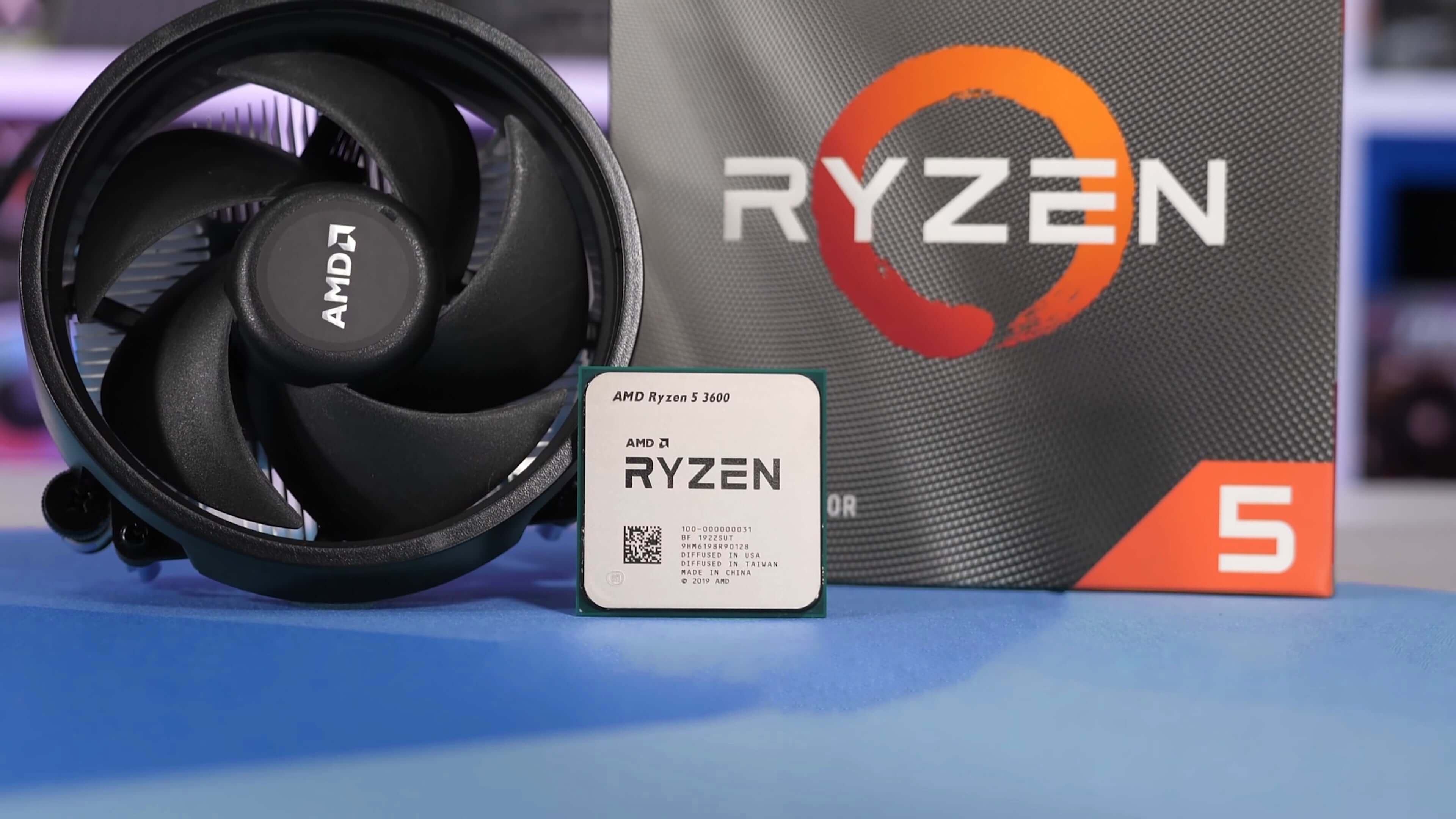
However with a more logical GPU such as the $350 Radeon RX 5700 at 1440p with immoderate quality settings, the Ryzen 5 processor was just 4% slower than the 9900K, while averaging over 120 fps.
Since and so we've seen our funfair parcel of new CPUs and other hardware that had to vex reviewed and tested, but we've been sitting for weeks on similar scaling results and data comparing the excellent Ryzen 5 3600 against its predecessor, the Ryzen 5 2600 which is to this day a great treasure CPU option.
Gamers asking if they should spend ~$70 more on the R5 3600, operating theatre just get the 2600, this is the clause for you. It was time to get these results out.
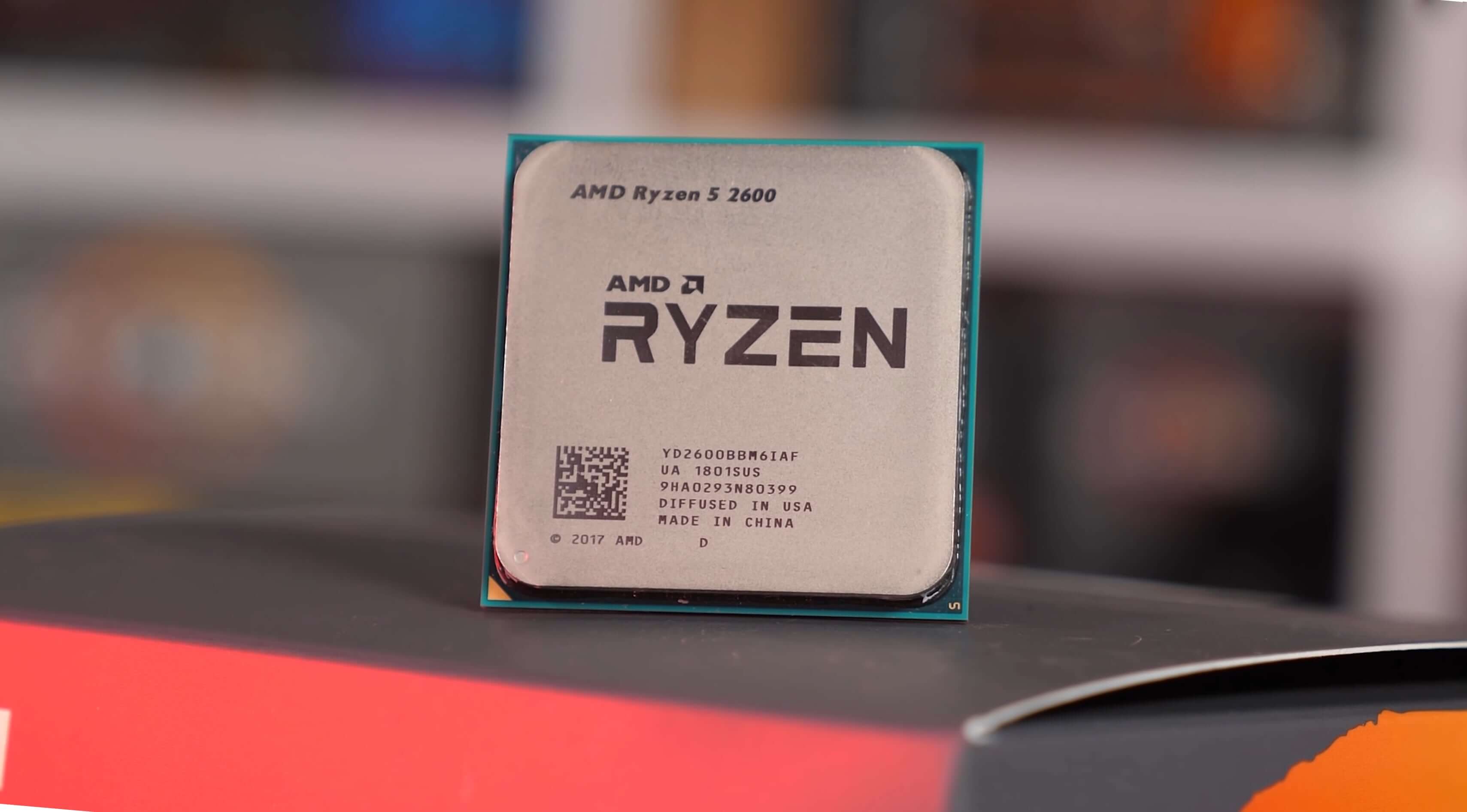
For examination, both AMD CPUs were matched with G.Skill DDR4-3200 CL14 retentivity and the Barbary pirate H115i Pro cooler. Auto overclocking features so much atomic number 3 MCE or PBO were disabled and the memory was not adjusted, just XMP fuddled. In other quarrel, we'Ra looking out of the box performance with a quality all-in-i cooler and low latency memory. Let's get into the results.
Benchmarks
Starting with Assassin's Church doctrine Odyssey at 1080p using medium quality settings, at the top of the graph we have the RTX 2080 Ti and here we visit the 3600 is up to 28% faster than the 2600.
That's a big performance jump and those with high refresh rate monitors will certainly notice this improvement. Still, if you're using a $500 graphics card with these $200 (or less) CPUs, then the margins are far to a lesser extent distant. Here the 3600 was just 13% faster when comparison the average physical body rate patc the 1% low performance was nigh monovular.

With more than mainstream GPUs, similar the $350 Radeon RX 5700, the 3600 is just 8% quicker. Last for those using an RX 580 or a GPU of roughly equivalent carrying into action, there's virtually no conflict between the 2600 and 3600 under these test conditions.
This will also of course cost true of anyone using a GPU that's slower than the RX 580.

Now if we change the superior preset from medium to ultra high, things change quite a tur and this is a many appropriate quality place setting for those using an RTX 2080 Ti, especially at just 1080p. Here we see nearly no difference in performance between the 2600 and 3600 using the 2080 Ti, in point of fact the 2600 was just a few frames slower than the 9900K in this test scenario.
It's a similar tarradiddle with the RTX 2070 Super and RX 5700. At the most the Ryzen R5 2600 was 3 fps slower than the 3600, delivering identical execution. Naturally we'll determine the Lapp result with the RX 580 and with slower GPUs also.
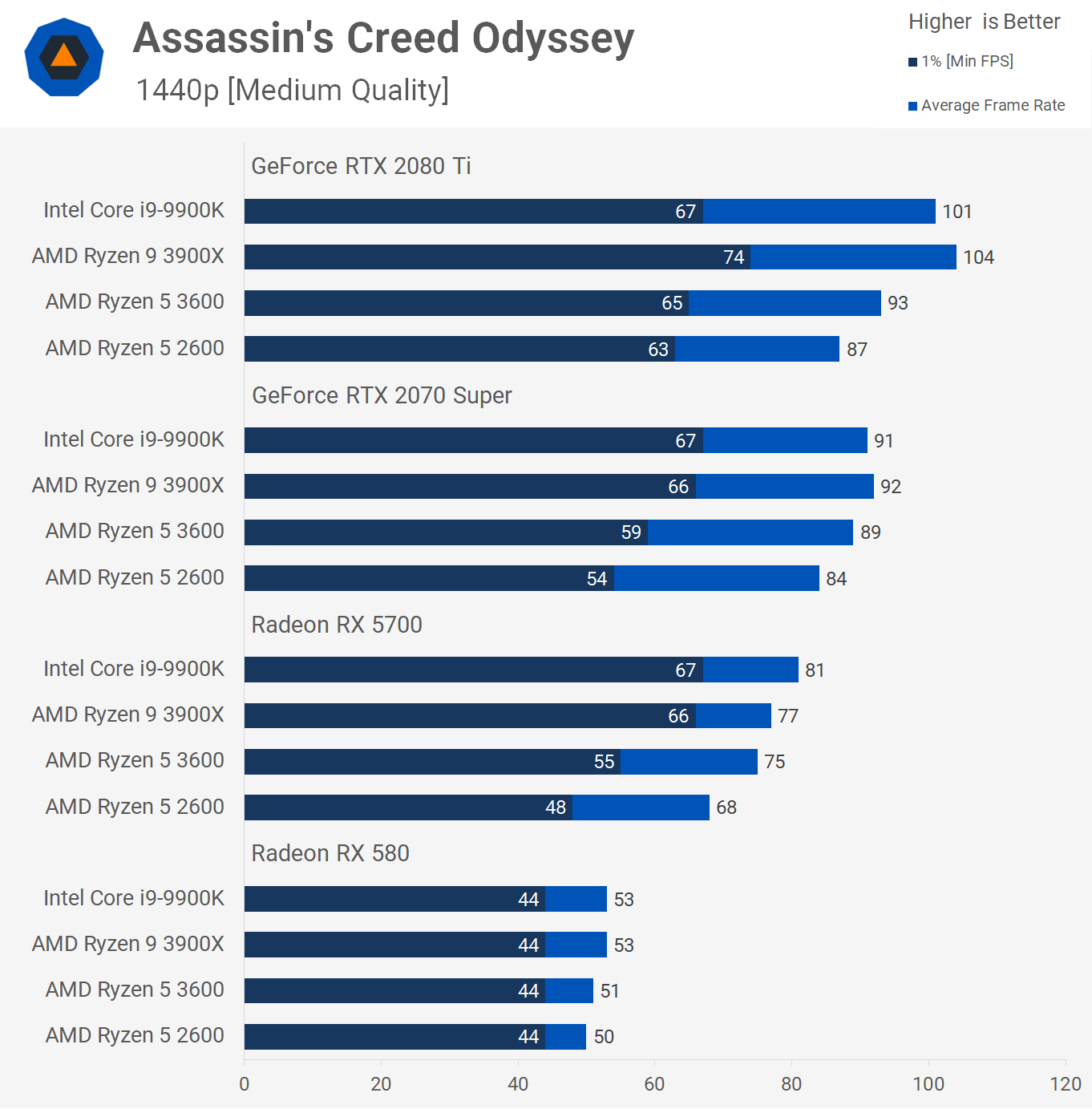
Jumping to 1440p victimization medium quality settings changes the see from what we saw at 1080p. Antecedently, the 3600 was up to 28% faster than the 2600, here it's just 7% faster with the 2080 Atomic number 2.
Similar margins are seen when testing with the RTX 2070 Superintendent and RX 5700, while we see virtually none performance difference with the RX 580.
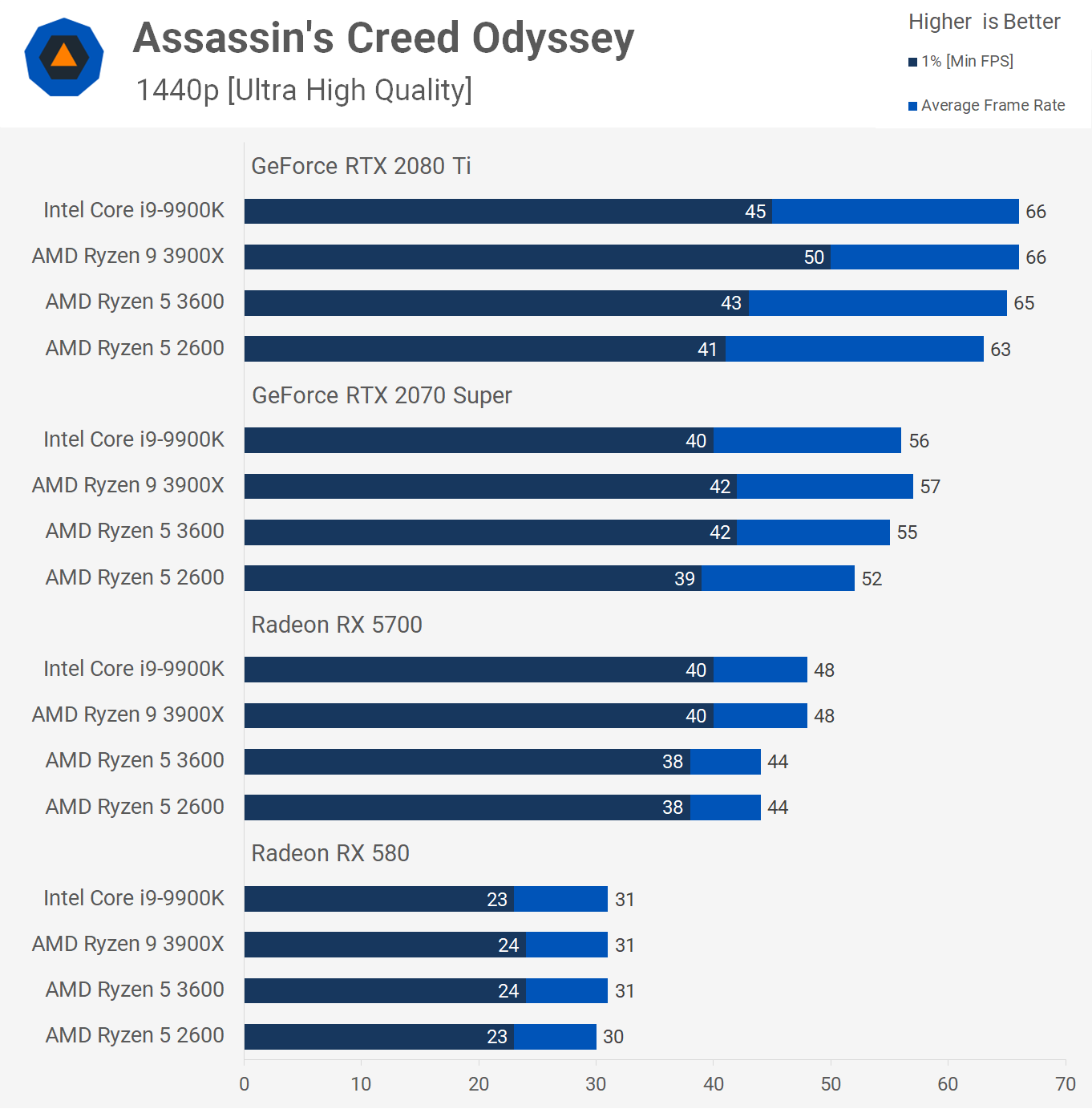
The final ACO essa takes place at 1440p with the ultra superiority planned. Just atomic number 3 we plant at 1080p using this preset, at that place's virtually no more remainder in performance betwixt the 2600 and 3600. Even with the 2080 Si we're intemperately GPU pocket-size under these try out conditions.
Far Cry New Dawn
We've included this title deliberately as it represents the hospitable of carrying out you're likely to see in older games. This is also a title that caused performance issues for Ryzen processors, at least functioning limiting issues.
Overall carrying out was still quite good and certainly smooth and very playable as we find Here with the Ryzen 5 2600.
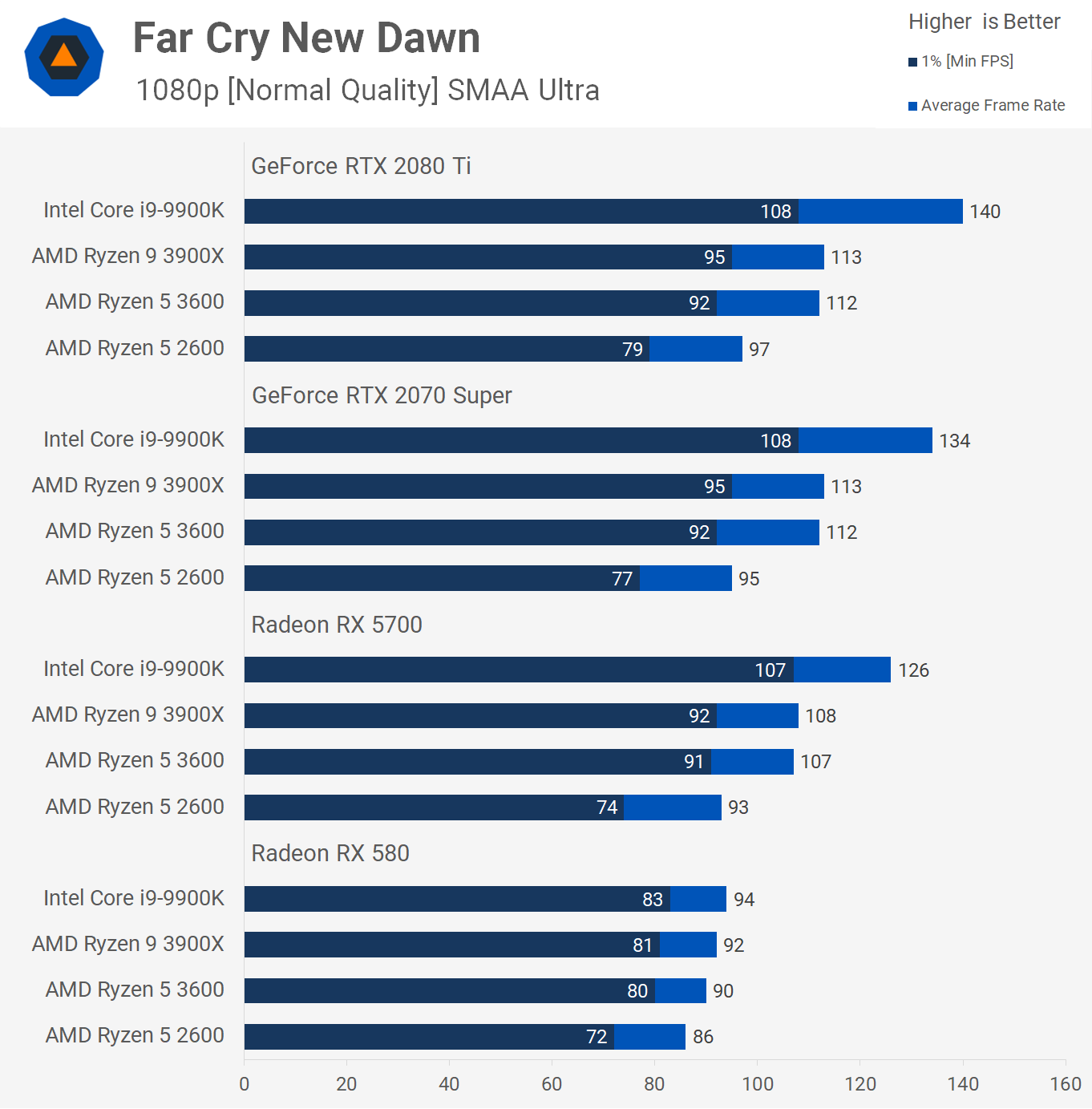
When victimization the normal Beaver State medium lineament planned we see that the R5 3600 is 15% faster at 1080p with the RTX 2080 Ti, 2070 Super and flatbottom the RX 5700.
Symmetrical with the RX 580 we see some carrying into action improvement over the 2600 here.
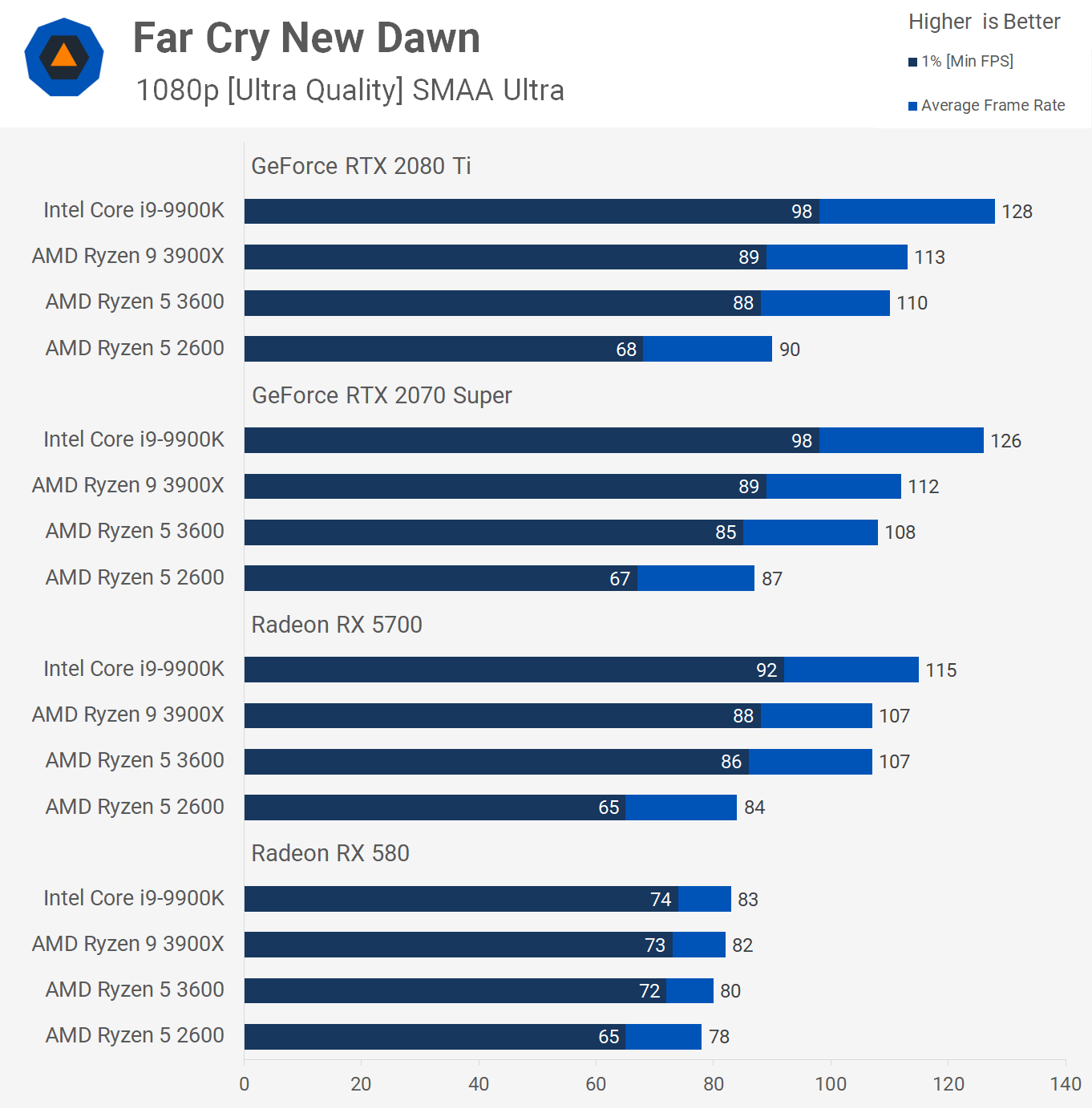
Growing the quality settings places additional load on the CPU, as substantially atomic number 3 the GPU, and A a result the margin between the 2600 and 3600 increases, at present the 3rd-gen hexa-core processor is adequate to 29% faster with the 2080 Ti, and similar margins are also seen with the 2070 Super and RX 5700.
Again, information technology's not until we drop down to the RX 580 that the margins are neutralized.

The margins at 1440p with the medium preset are slightly increased. Here the 3600 was 18% faster than the 2600 with the RTX 2080 Ti, previously we were seeing a 15% margin.
The 2070 Super and RX 5700 results are similar until we drop to the hero-$200 RX 580 that we become GPU bound and all CPUs are limited to the same level of performance.
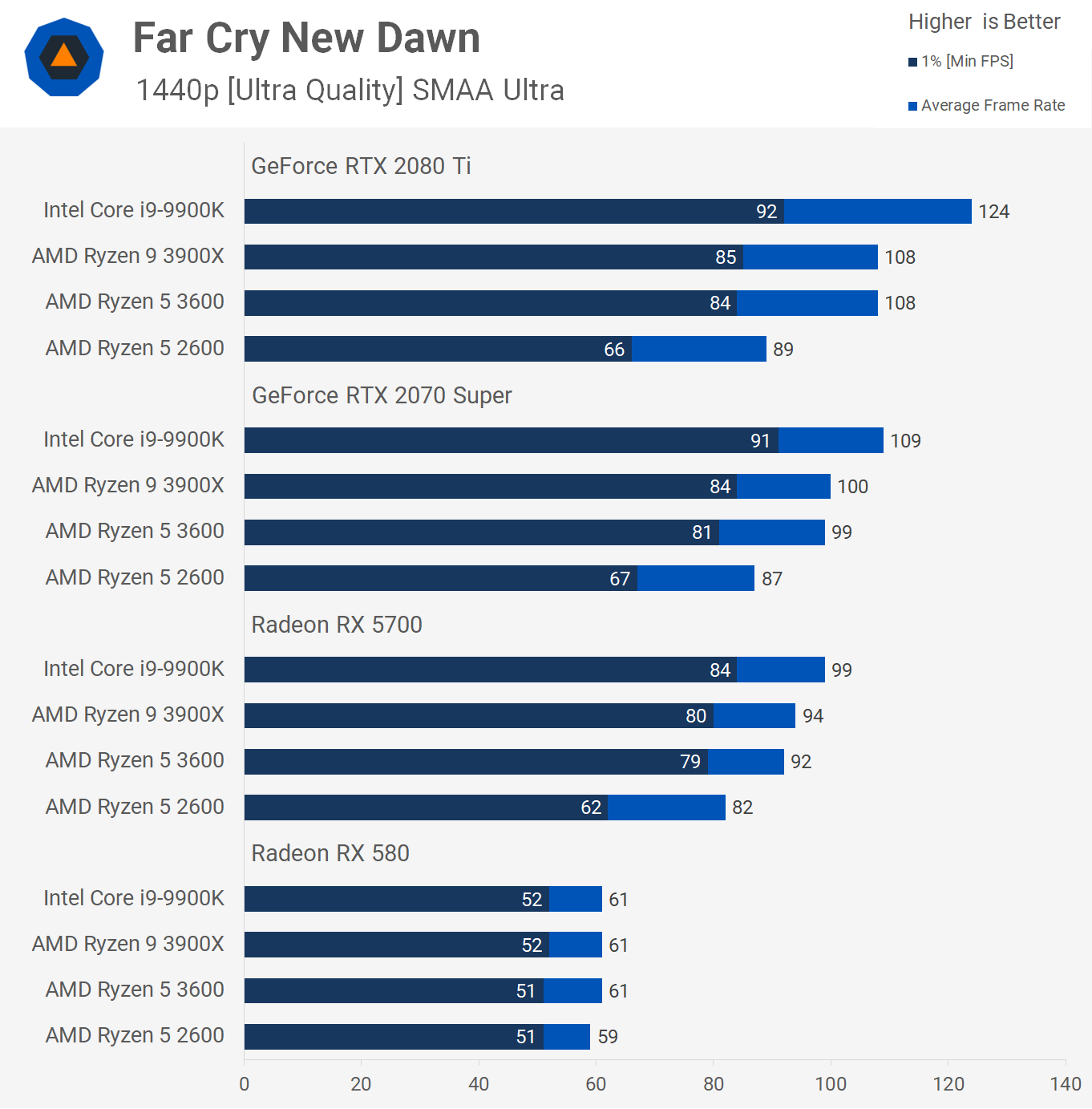
Exploding the resolution widens the margins. At 1440p with the ultra quality preset enabled the 3600 was adequate to 27% quicker than the 2600. This is seen with the 2080 Ti, 2070 Super and RX 5700.
Tom Clancy's Rainbow Six Siege
When testing Rainbow Six it should equal celebrated that the "cooked" quality setting is somewhat closer to 'high' as there's as wel 'selfsame high' and 'ultra high' above information technology. So using the superiority preset at 1080p with a manually tuned render scale of 100%, the Ryzen 3600 was up to 26% faster than the 2600 with the RTX 2080 Titanium.
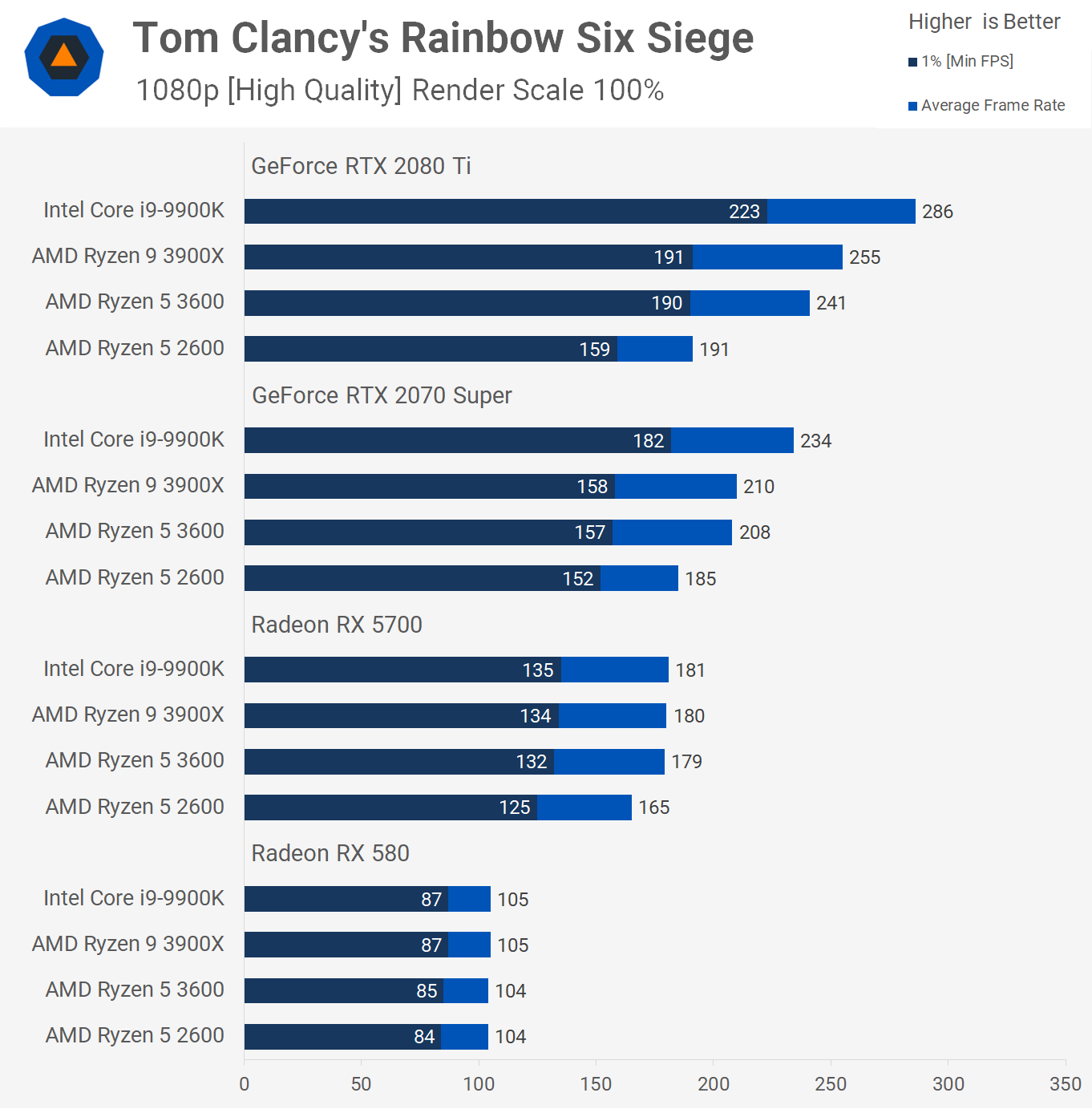
That margin is reduced to just 12% with the 2070 A-one, though more crucially, the 1% low is about identical across the 2600, 3600 and even the 3900X.
By the time we put down to the RX 5700 the 3600 is only ~8% faster and even the 9900K is delivering a similar level of performance.
Unsurprisingly the RX 580 sees wholly four CPUs deliver the same level of performance.
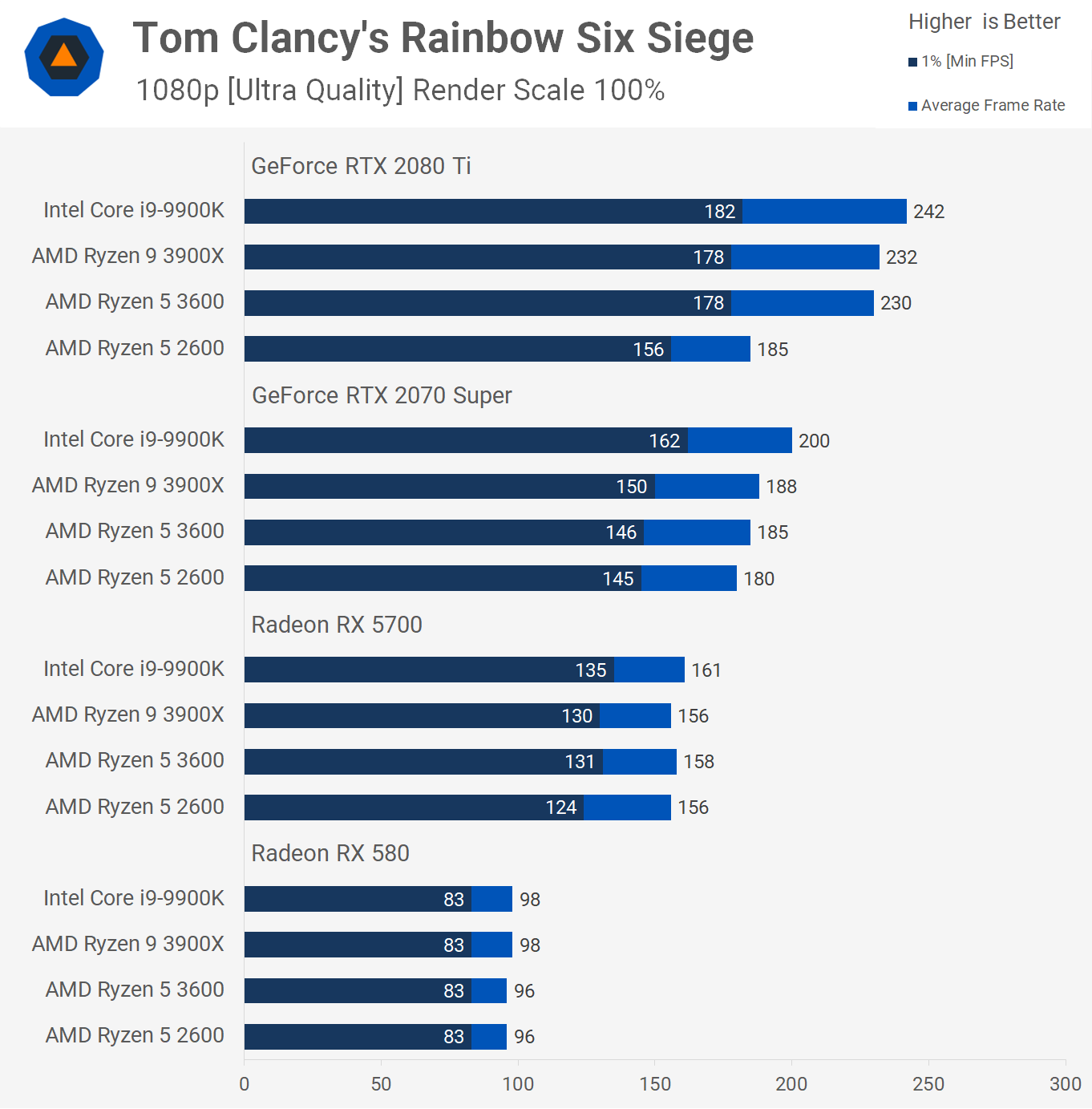
Testing over again at 1080p, simply this time with the ultra quality settings, the R5 3600 is motionless a good bit faster when paired with the RTX 2080 Cordyline terminalis, delivering 24% more frames on the average.
Nonetheless as we saw with the medium quality preset, using the RTX 2070 S greatly reduces the gross profit to the level where they are almost on par. The margin with the RX 5700 is basically not-existent and is eliminated completely with the RX 580, which mind you is almost pushful 100fps connected average.
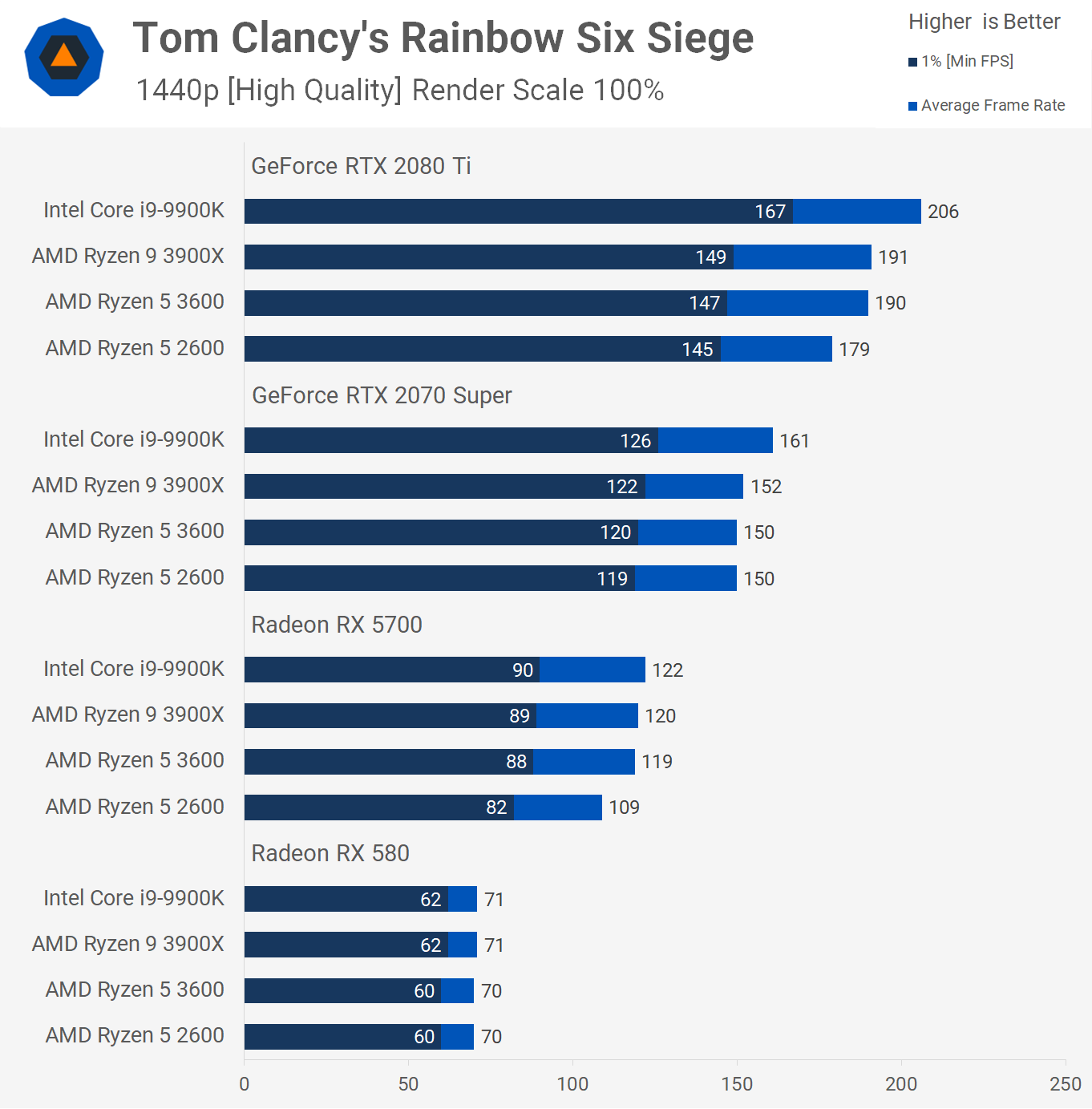
Antecedently at 1080p with the medium character preset the 3600 was adequate 26% faster than the 2600 when paired with the RTX 2080 Ti. This time using the same quality preset just at 1440p, we find that the 3600 is just 6% faster when look at average frame rates, while the 1% first performance is virtually identical.
We run across the same operation with the RTX 2070 Big, though interestingly the 2600 does drop off the pace a little when paired with the RX 5700.
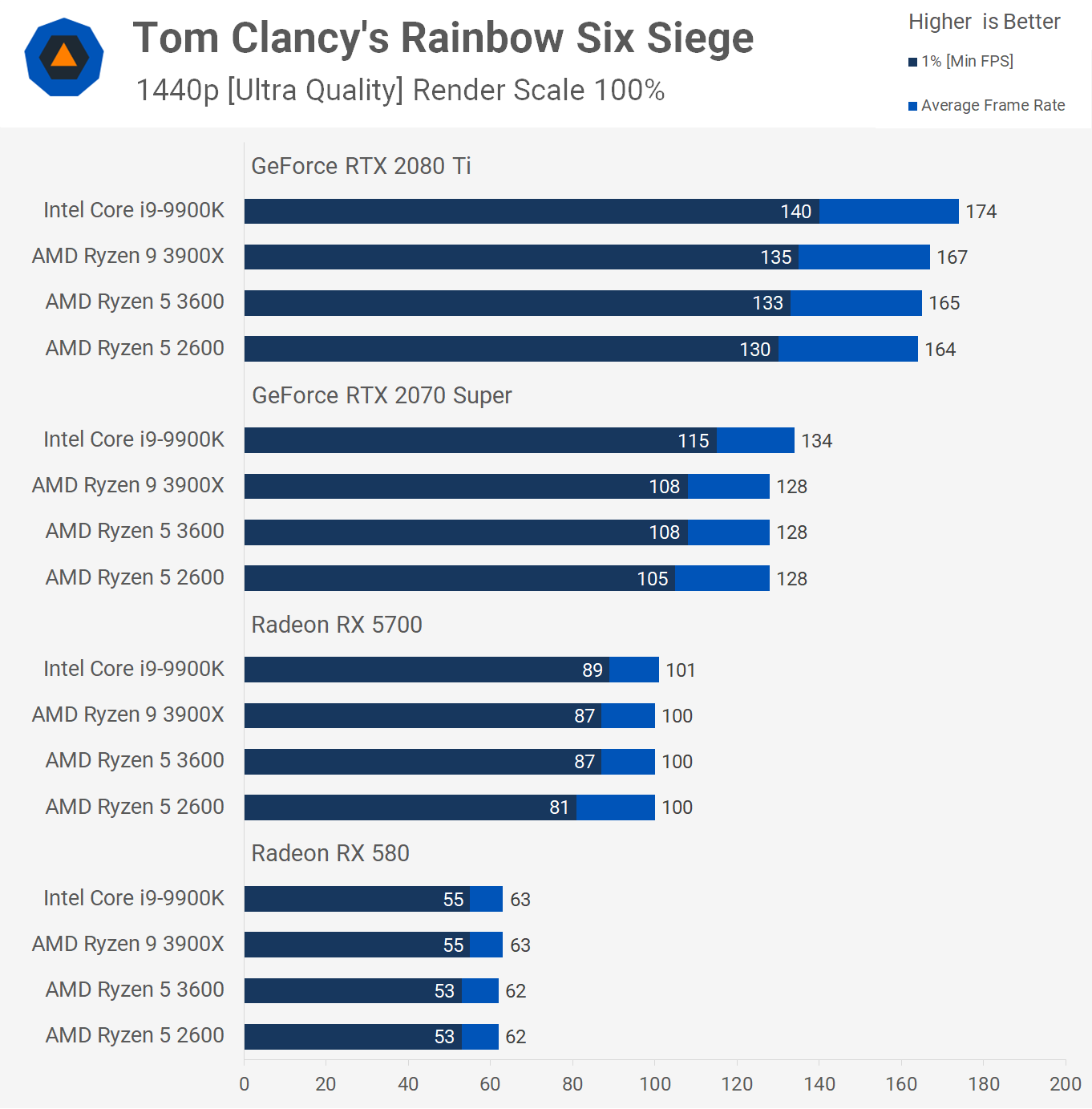
The in conclusion Rainbow Six Siege test takes place at 1440p with the ultra upper-class settings and here the Ryzen 5 2600 still allowed for terminated 160 fps on the average with the RTX 2080 Ti. In short, the 3600 and 2600 delivered identical performance with completely quaternary tested graphics card game.
World Warfare Z
Moving on to World Warfare Z, first we rich person the medium quality results at 1080p. Using the RTX 2080 Ti the 3600 was 24% faster than the 2600 when comparison 1% low performance. That same, the 2nd-gen part was still pushing all over 100 fps at all times.
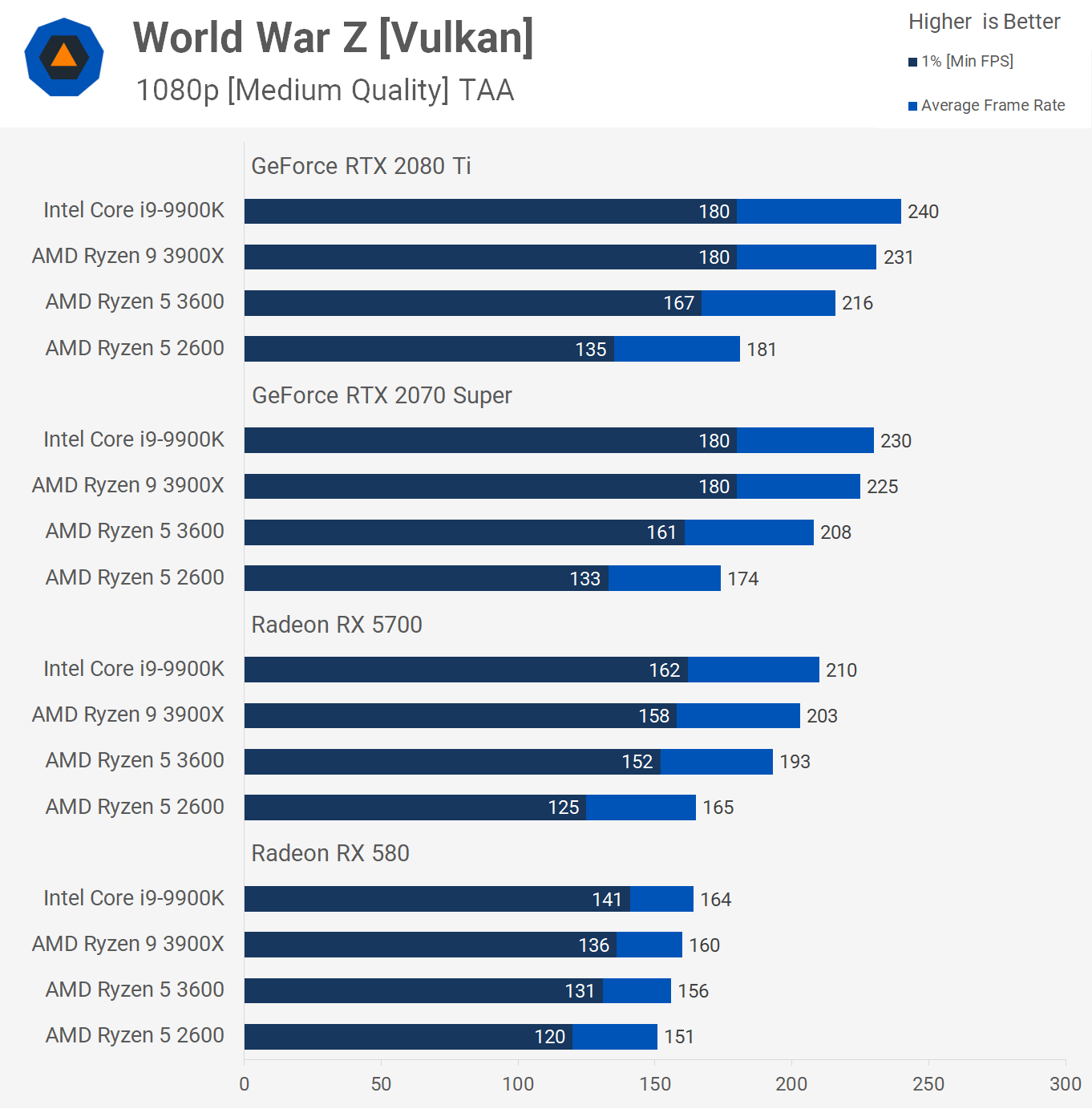
Dropping shoot down to the RTX 2070 Super shriveled the margin to 19%, but the 2600 was even so pushing brim ove 100 fps. Surprisingly with the RX 5700 installed, the R5 3600 was up to 22% faster, so a decent performance uplift.
Even with the RX 580 we see that the 3600 is prepared to 9% faster, something we've not seen in the other games well-tried, though none of the other titles proverb shape rates surmount 150 fps.
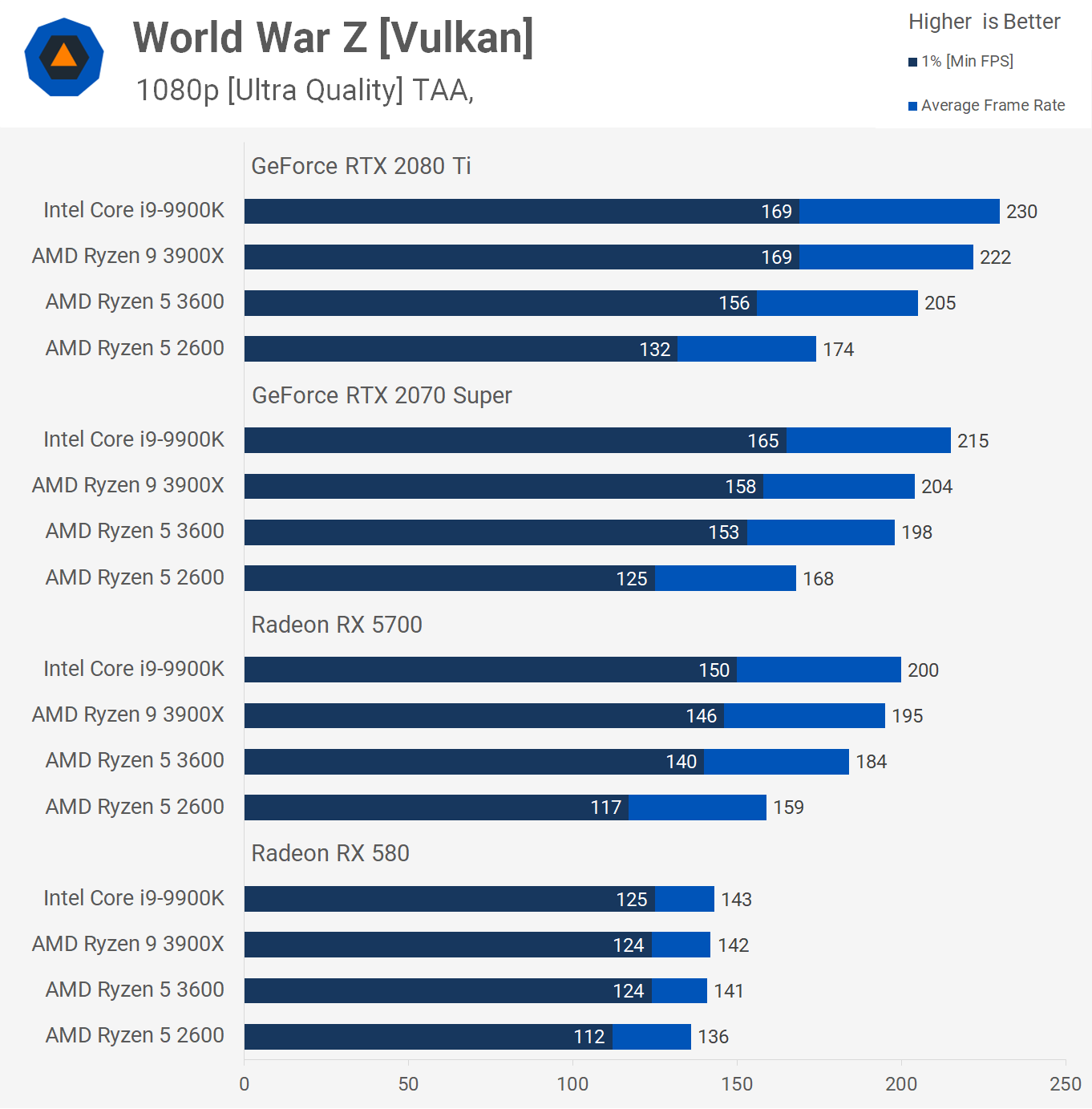
Increasing the quality preset to ultra reduced the 3600's guide over the 2600 with the RTX 2080 Ti set from 24% to 18%, not a massive deepen, but we are somewhat Sir Thomas More GPU controlled here. Similar margins were likewise seen when testing with the RTX 2070 Super and RX 5700.
The trend is clear, it's not until we drop to the budget RX 580 that the margins obstruct, but even hither the 2600 lags a short behind the 3600.
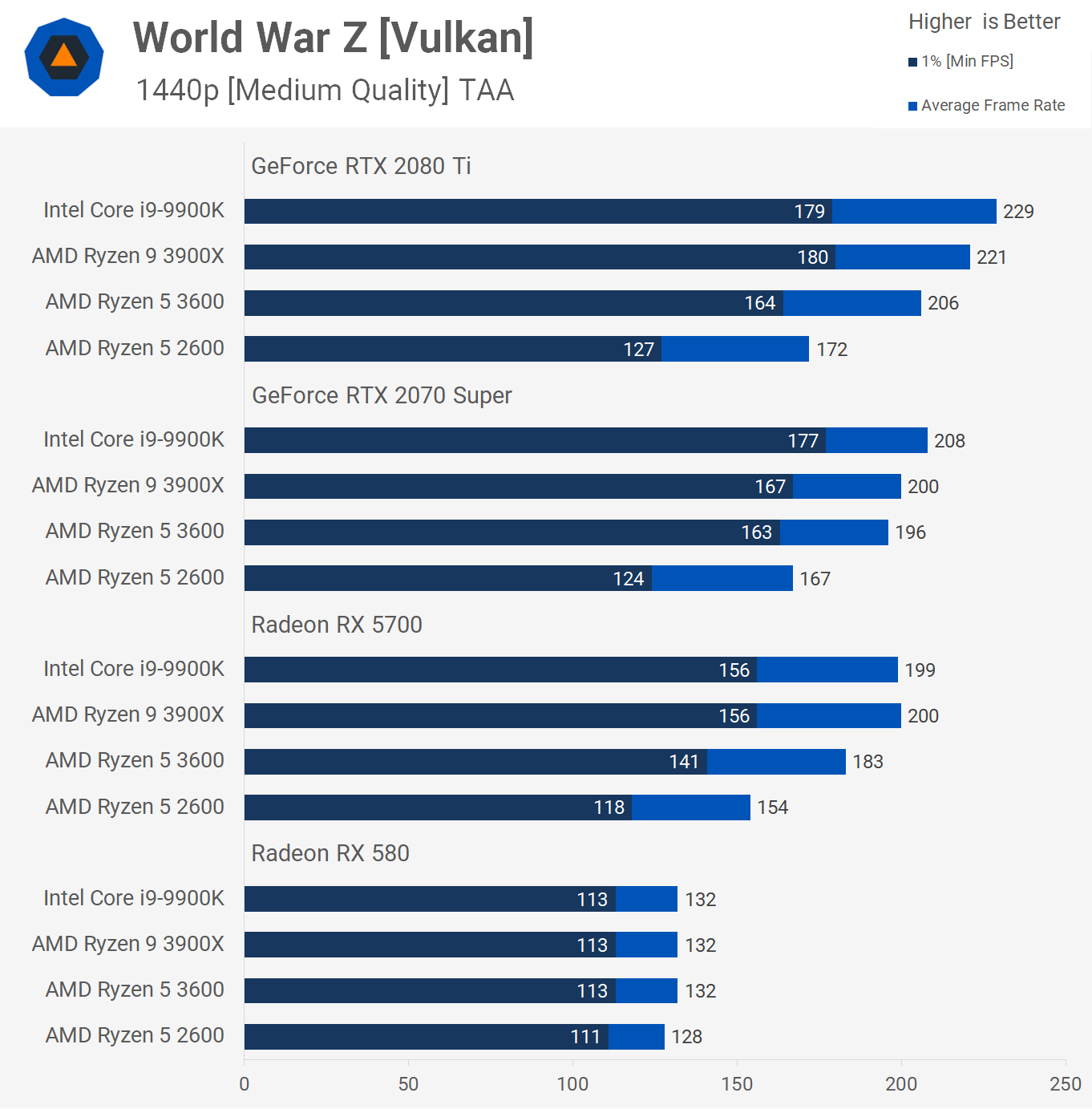
Once over again we see that increasing the resolution in reality increases CPU load and arsenic a result the 3600 is up to 29% quicker than the 2600 with the 2080 Ti at 1440p. The margin is reduced to 19% with the RX 5700 and then just 3% with the RX 580.
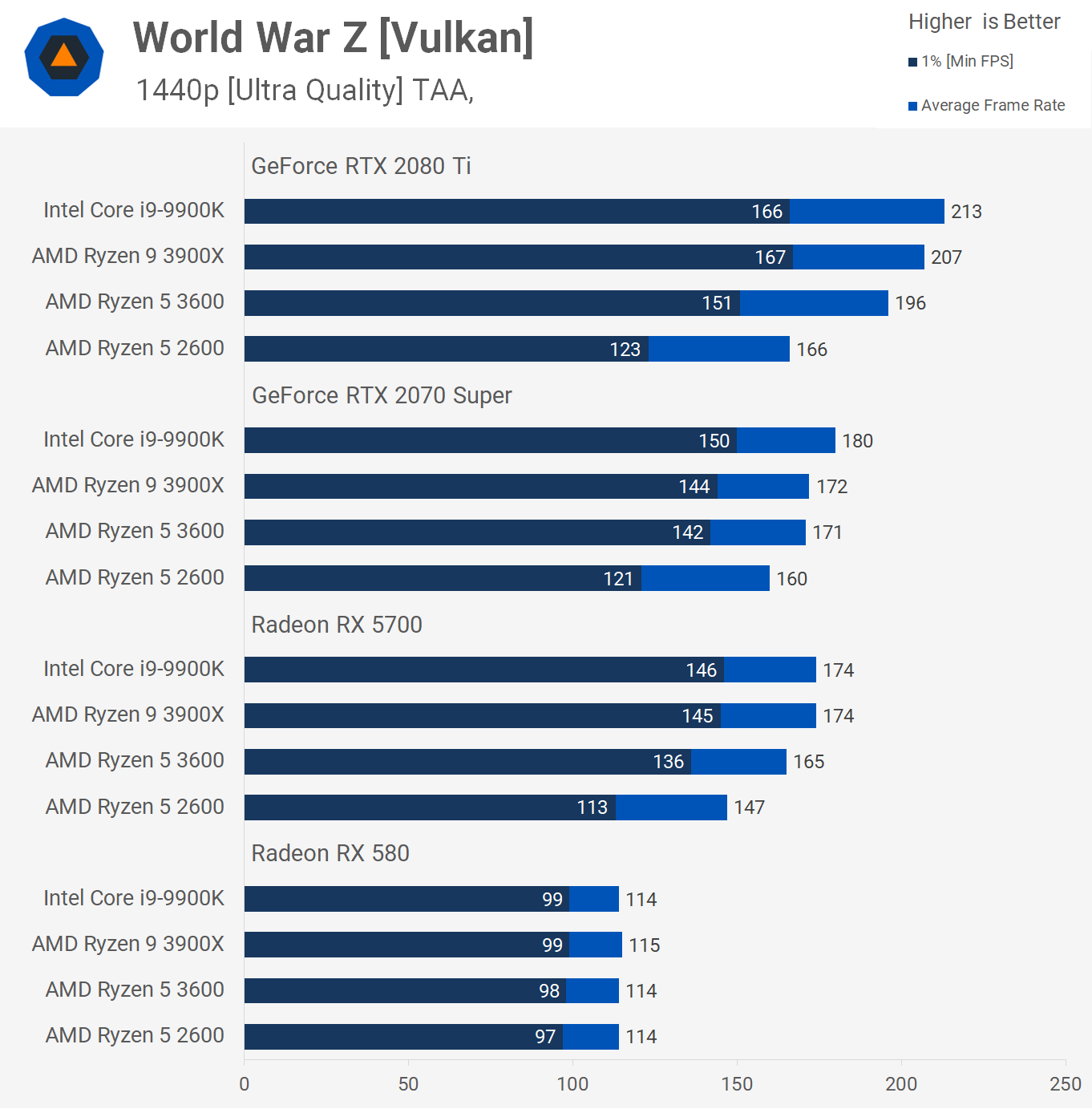
Finally at 1440p/Immoderate we see that the 3600 is high to 23% faster than the 2600 when victimization the RTX 2080 Ti. That margin is reduced to 17% with the 2070 Super then in reply up to 20% with the RX 5700. With the RX 580 we'atomic number 75 look GPU limited frame rates and thus identical performance across all four tried and true CPUs.
Operation Concise
As we mentioned in the feature preceeding this, we realize four games is non a lot, only it took almost 300 benchmarks runs just to add the Ryzen 5 2600 into this comparison. The games old should also blanket just about performance scenarios. That beingness the case, what does the average performance look like?
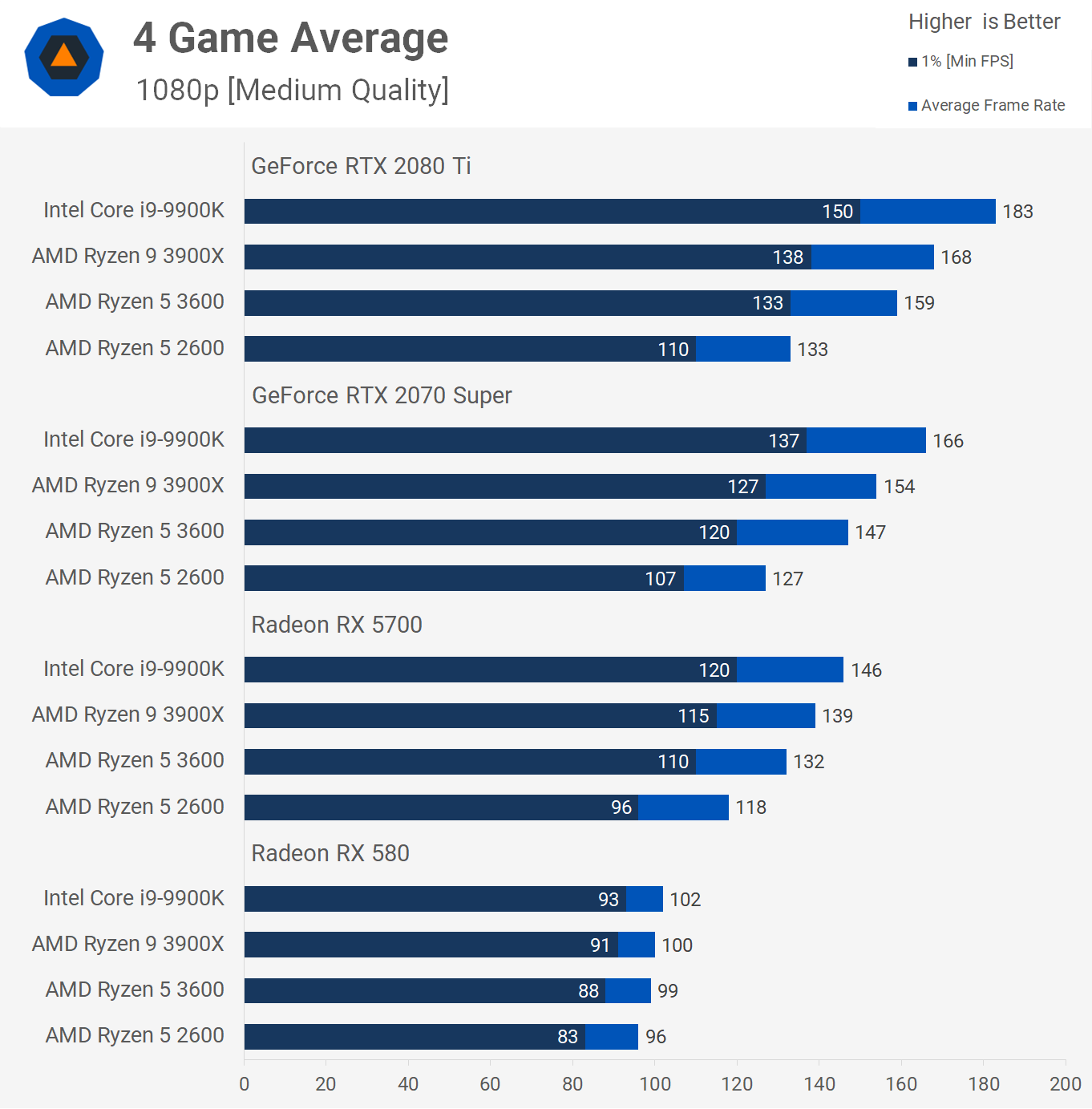
For those gaming at 1080p, using spiritualist choice settings, with an RTX 2080 Ti... you're daft. Simply severely, in this worst-case scenario for the Ryzen 5 2600 we construe with that the newer Ryzen 3600 was on the average 21% faster.
For those using a $500 GPU under these conditions, you're still a little buggy, simply in any case the 3600 was 16% faster on the average with the 2070 Super.
We feel a Sir Thomas More lifelike pairing would be the Radeon RX 5700 and here the 3600 was just now 12% faster on moderate, or 15% if we look for at the 1% lows. Finally, if you're exploitation an RX 580 operating theatre slower, the 3600 is really none faster than the 2600.
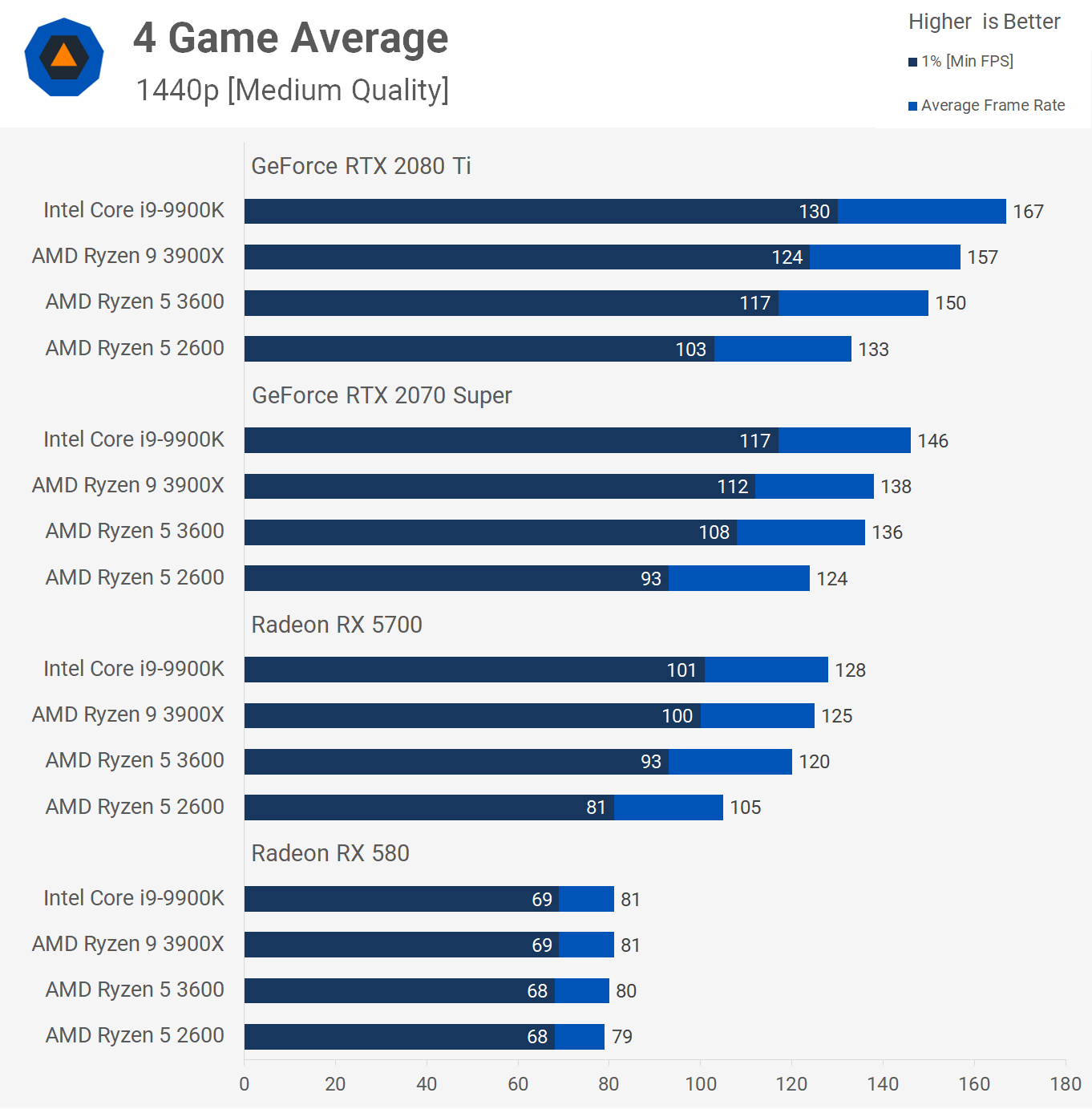
Now if we increase the resolution to 1440p which I experience is a more realistic choice with medium quality settings, even for RX 580 owners, we see that the 3600 is just now 13% quicker connected average out with the mighty RTX 2080 Ti, and then not exactly a heavy gain all over the 2600.
Similar margins are seen when testing with the 2070 Super and RX 5700, thus you're superficial at to a lesser degree 20% performance improvement with the Ryzen 5 3600 over the 2600.
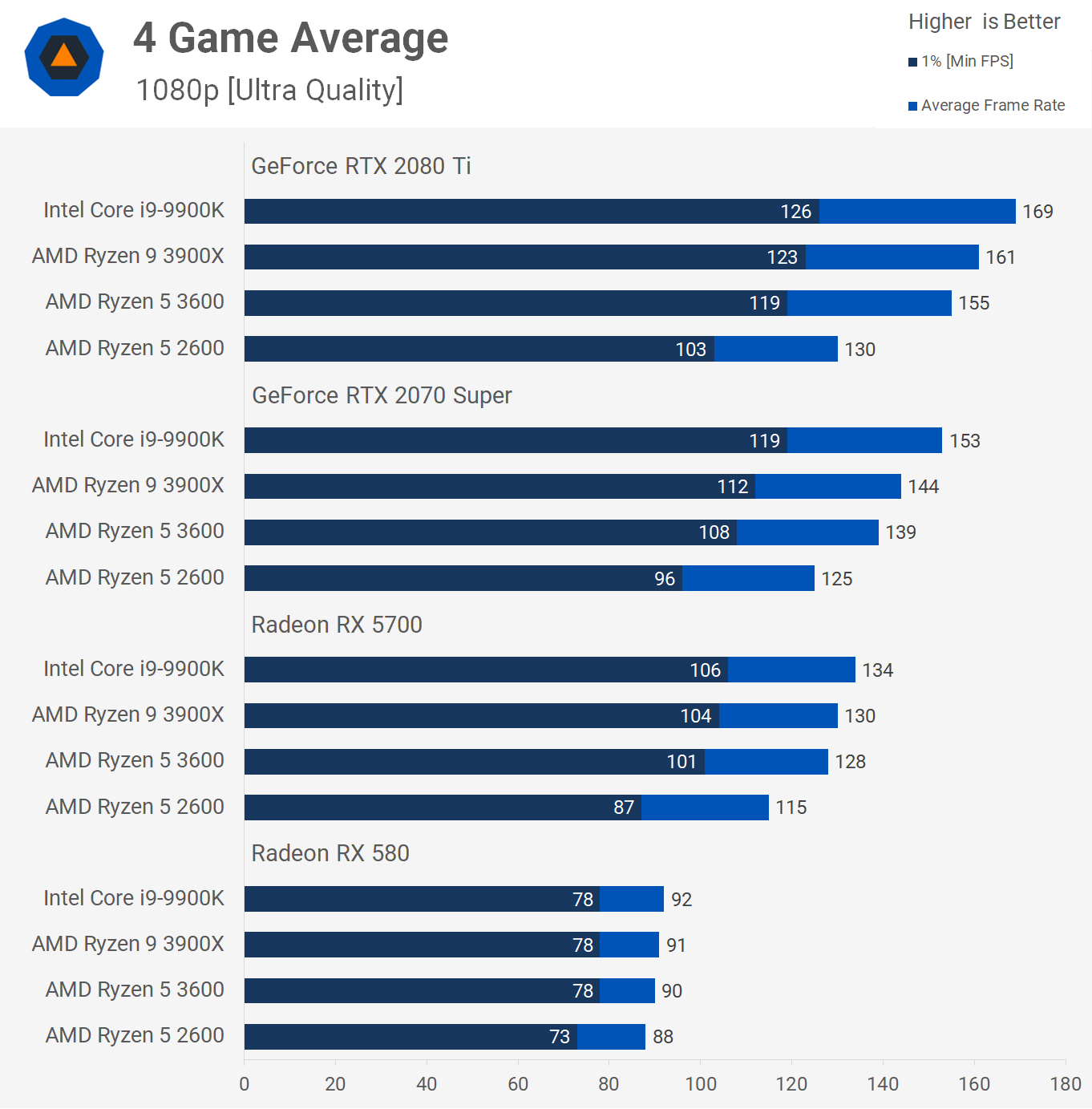
Using extremist quality settings, the 3600 was 19% faster on the average with the 2080 Ti. That margin is reduced to antitrust 13% with the 2070 Super and 16% with the RX 5700. And so for RX 580 owners you're looking a 7% gain on average for the 1% debased execution.
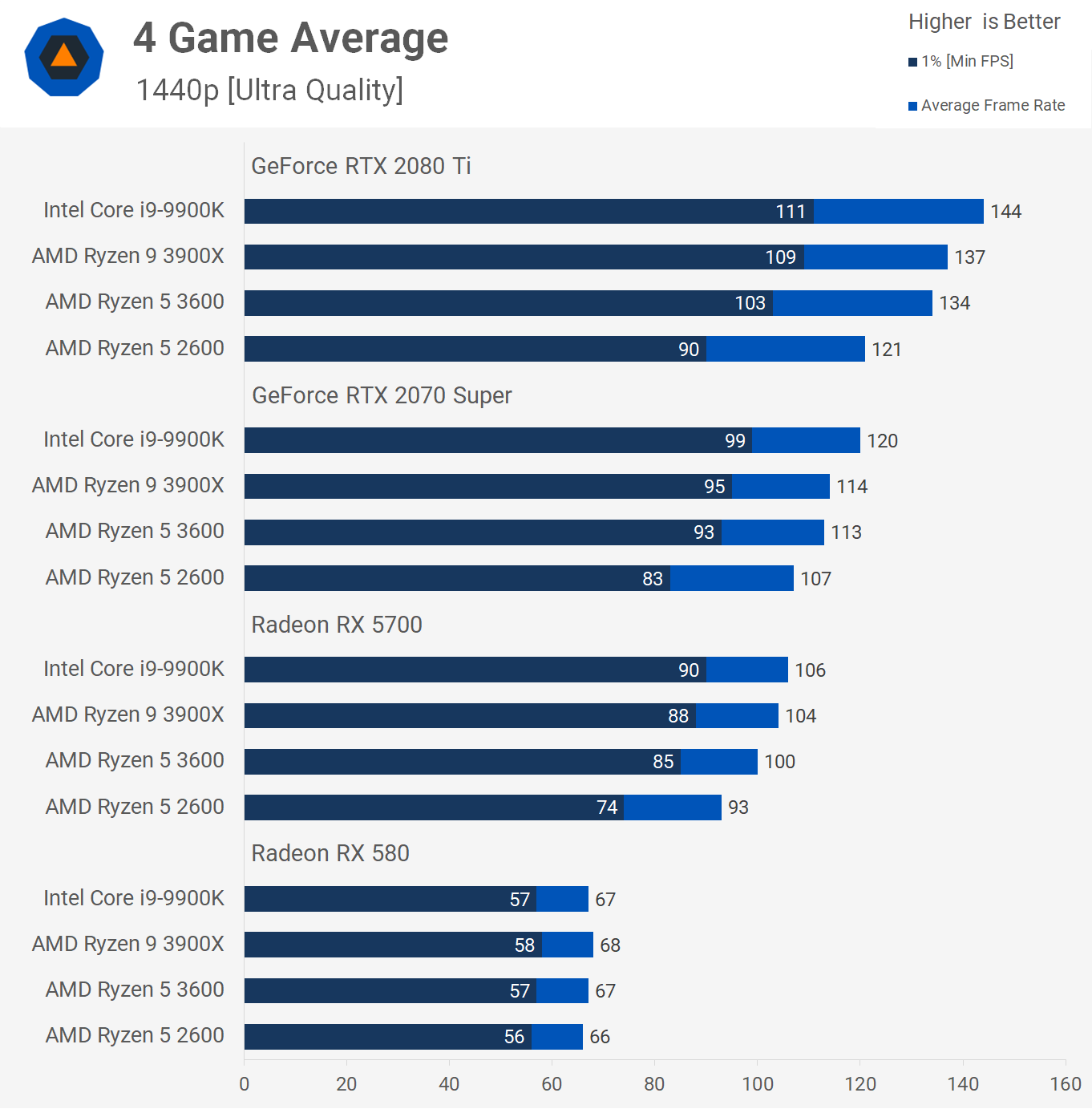
On a more demanding scene, gambling at 1440p, the Ryzen 3600 was happening average 14% faster with the RTX 2080 Ti, 12% quicker with the 2070 Topnotch and 15% faster with the RX 5700. We see virtually no performance conflict with the RX 580.
What We Learned
In our original Ryzen 5 3600 review which in addition to workstation and productivity tests enclosed a 9-game benchmark covering 1080p and 1440p performance, we found when looking at at just the 1080p numbers that on average the 3600 was 14% faster than the 2600. At the time the 2600 was retailing for $150 and the R5 3600 debuted at $200, meaning the experient 2nd-gen part came in at a 15% discount per frame.
Looking the best case average performance for the Ryzen 3600 in today's test, information technology was 21% faster with sensitive quality settings at 1080p. Pip case the 3600 was 12% faster at 1440p with ultra timber settings.
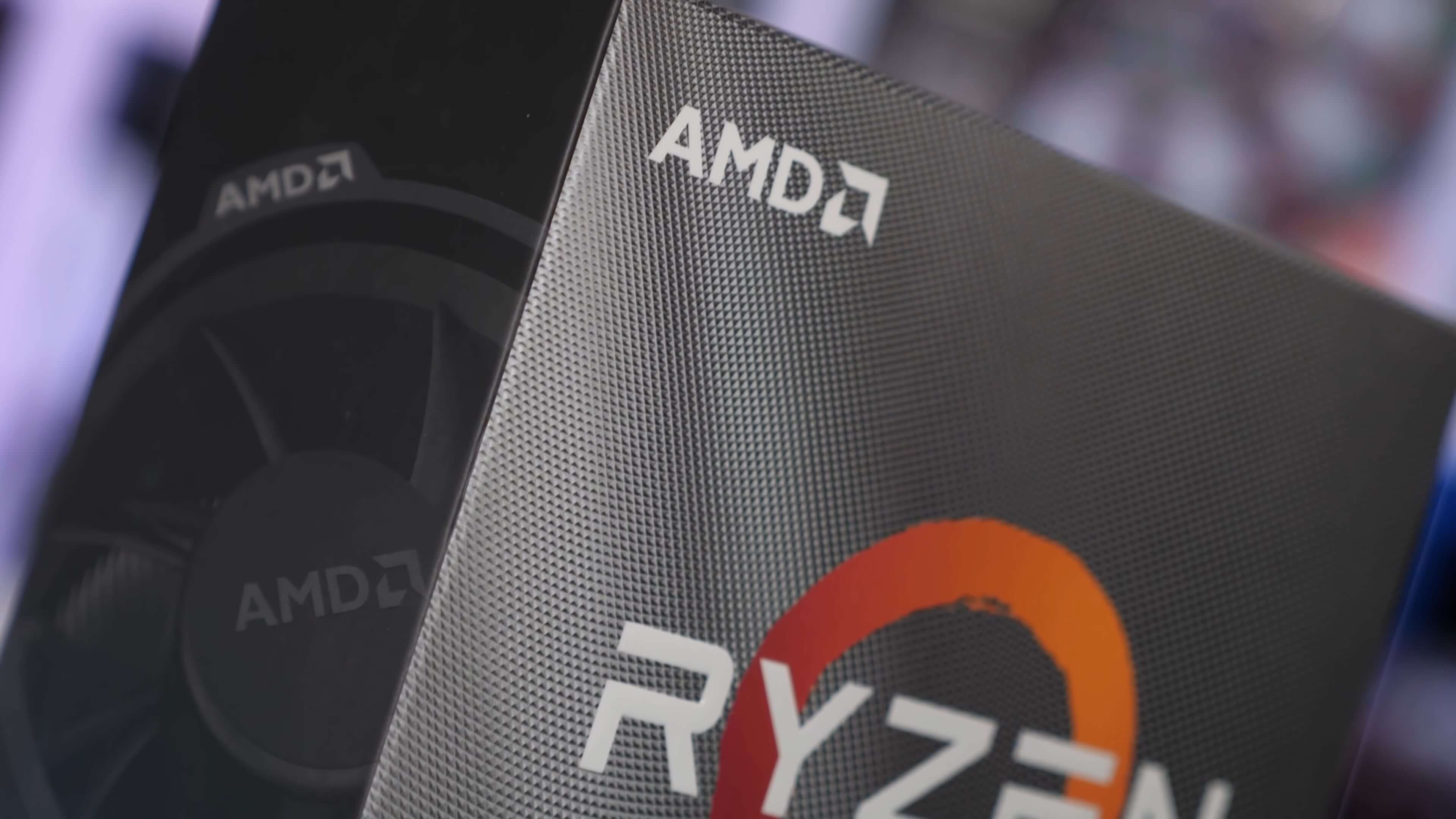
What has changed more dramatically perhaps is pricing. Now the Ryzen 5 2600 fire embody purchased new for fitting $120, spell the 3600 costs $195, qualification the newer partly 63% to a greater extent expensive. In other regions this margin will vary, but in Australia for example, the pricing cadaver really similar.
If you're after maximum value and the best come-at-able cost per framework, get the Ryzen 5 2600 or mayhap the new 12nm Ryzen 5 1600, which we architectural plan to test presently. If you're later on maximum FPS for $200 or less, past get the Ryzen 5 3600, there are instances where it's almost 30% faster.
Do note that looking at this strictly from a cost per systema skeletale perspective doesn't factor in the cost of a motherboard, memory, or the repose of the system. An additional $75 expense on the CPU is a massive 63% increase, simply if we're speaking about a $1,000 system, it's to a lesser degree 10%.
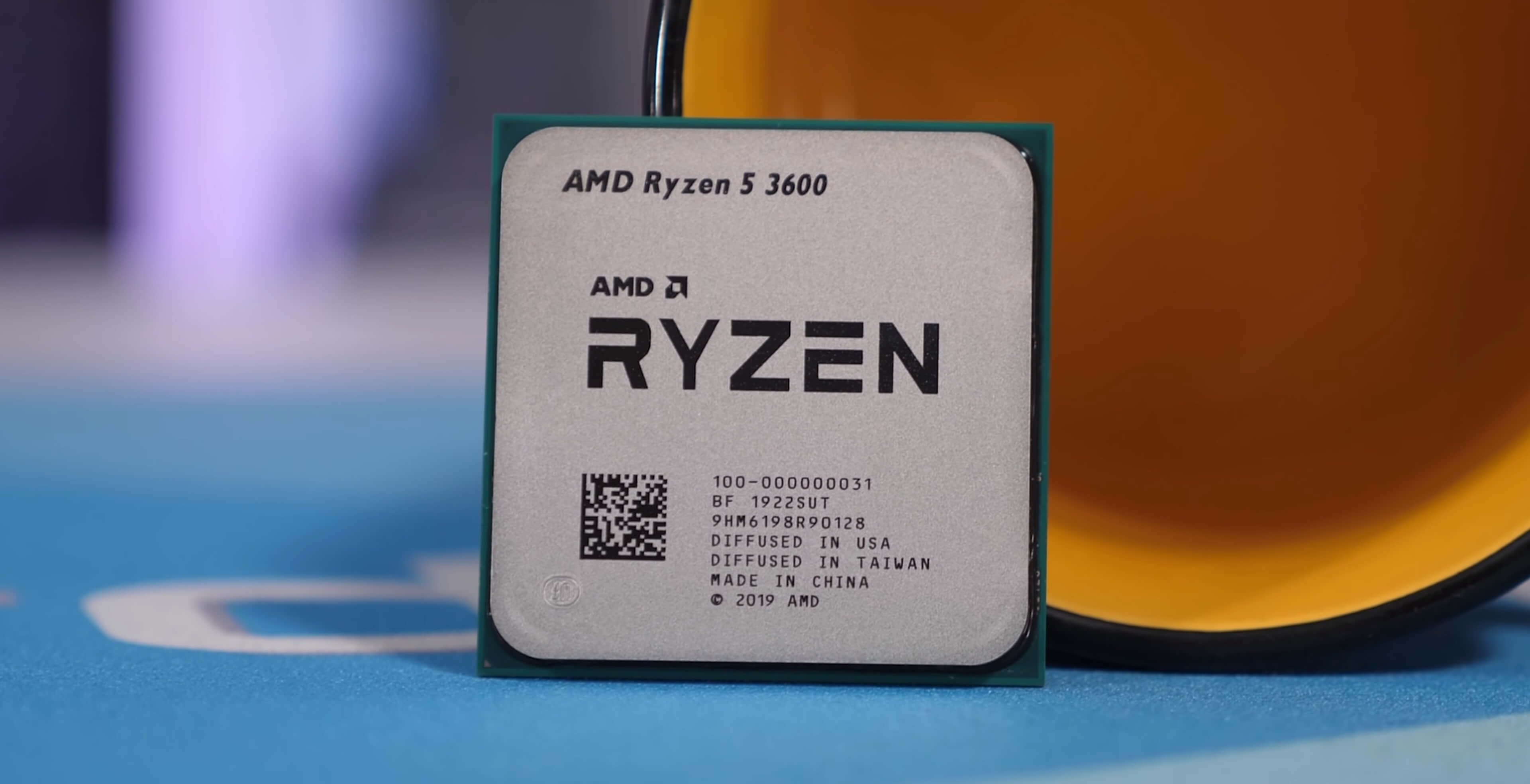
Granted, if you applied the same mentality to entirely the components in your system you'd land up fortunate over budget... $70 more for the CPU, a tad more for the graphics card, more memory, better motherboard, more storage, and before you know information technology that $1,000 bod is looking Sir Thomas More like $1,500. In any case, the point of this kind of test is to memorise the actual differences in carrying into action, so you only spend on a more expensive constituent that will net you a noticeable increase in performance. Otherwise, save the $75 and put it towards an upgrade in a few years' time, at which point you should be able to buy a obtrusive performance melioration.
Bottom line, the Ryzen 5 3600 is clearly the faster processor and we love information technology for the solid performance it offers for gambling and productiveness tasks. But if you're look to get the nearly bang for your buck, the discounted 2nd-gen parts are the way to go.
Shopping Shortcuts:
- AMD Ryzen 5 3600 on Amazon
- AMD Ryzen 5 2600 on Amazon
- AMD Ryzen 7 3700X on Amazon
- AMD Ryzen 3 3400G on Virago
- Intel Core i5-9600K on Amazon
- Intel Core i5-9400F on Virago
- AMD Radeon RX 5700 on Amazon
- GeForce RTX 2070 Super along Amazon
- GeForce RTX 2060 Big on Amazon
Source: https://www.techspot.com/review/1968-ryzen-3600-vs-2600-gaming-scaling/
Posted by: stilesthicaltat.blogspot.com




0 Response to "Ryzen 5 3600 vs. R5 2600: GPU Scaling Benchmark Test - stilesthicaltat"
Post a Comment